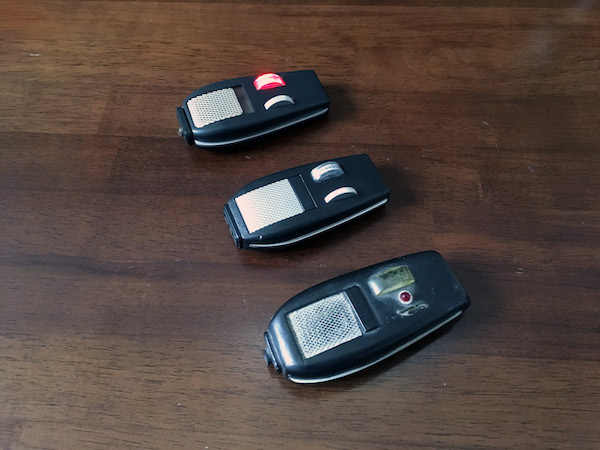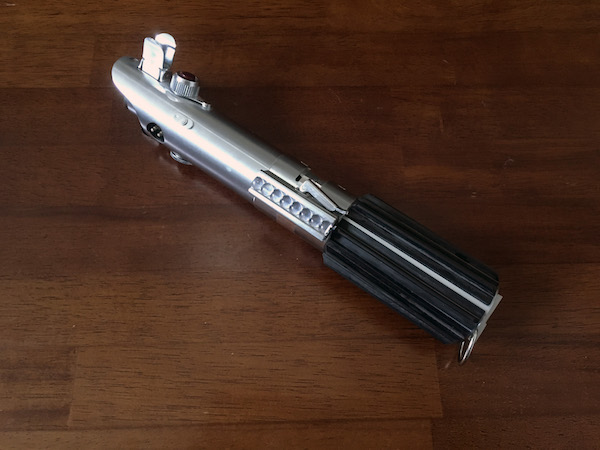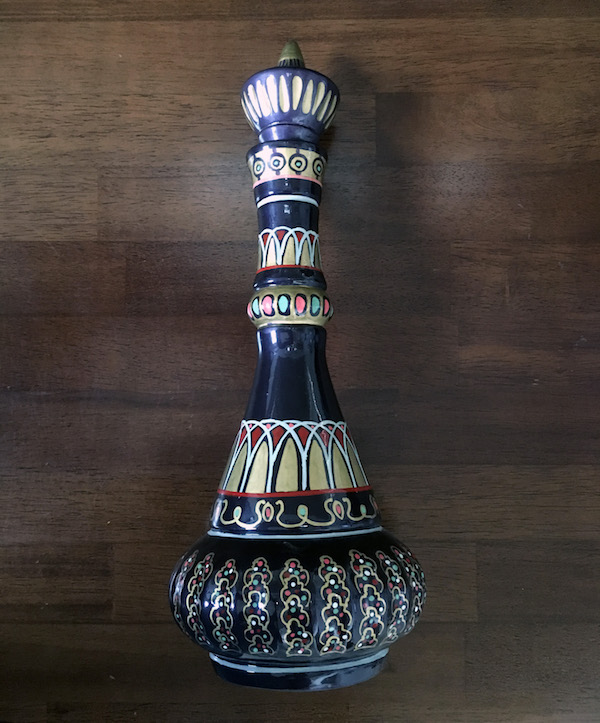In this ongoing series, we ask SF/F authors to describe a specialty in their lives that has nothing (or very little) to do with writing. Join us as we discover what draws authors to their various hobbies, how they fit into their daily lives, and how and they inform the author’s literary identity!
When I’m not trying to put good words to the page, I channel my creativity into a peculiar hobby.
Most people will take in repeated viewings of their favorite movie to recapture specific emotions from a favored scene. For some of us, the screen experience isn’t enough. We seek a more tactile connection to the stories that have touched us in some way. From our ranks come the memorabilia aficionados, the figure collectors, and the cosplayers. Tangentially connected to these fan bases are movie prop collectors.
While I dabble in some of the other hobbies I’ve mentioned, I count myself among the latter. Owning an actual artifact from a favored film is ridiculously expensive, especially if the object is central to the story. Luckily, replicas present a cheaper and more accessible answer.
What is a movie prop? It’s any object used by actors or in a scene during a film production, but importantly, not a costume or part of the set. The best ones, the ones that are the most fun to collect, are often critical to an iconic character or tied to a beloved story. Where would Indiana Jones be without his whip? Ripley without her motion tracker? Or Doctor Who without his sonic screwdriver?
For me, my obsession began in the mid-1980s. That’s when I attended my first science fiction conventions. At a Star Trek convention, I picked up a Marco Enterprises catalogue. Inside, were all manner of screen treasures; blasters and lightsabers; phasers, tricorders, and communicators; president trackers and agonizers. Quite literally the stuff dreams are made of. Keep in mind, this was still in the days of dial-up modems and bulletin board systems, long before the internet. I had no idea such things were possible, let alone available for purchase. Alas, I was still a youngster in high school and as much as I wanted everything in the catalogue, there was no way I could afford any of it. But it ignited the spark and I decided to make my own.
The first prop I made was from an old piece of pine with the help of a shop teacher. It is a replica of a Type I Phaser from Star Trek. It is a bit worse for wear now. I need to repair the dial, but I still have it.

My construction and collecting took a hiatus while I was in college, but afterward came back more powerful than I could possibly imagine. By then the internet was coming into its own and we replica prop creators and collectors were no longer in a vacuum. One great thing about those days was that collectors were often working with the same materials the original movie prop masters had used to create these icons. So, if I wanted the most accurate replica of Luke Skywalker’s lightsaber from Star Wars: A New Hope, all I had to do was track down an old Graflex 3-cell flashgun, the bubble lenses from the right model of Texas Instruments calculator, some hard plastic T-tracks for the grips, and I’d be off to a pretty good start.

Some builds are easier than others. When I wanted a replica of Jeannie’s bottle from I Dream of Jeannie, I needed the right whiskey decanter and paint. For other props knowing which parts I needed was the critical limiting factor and required a significant amount of detective work, since most movie production houses don’t exactly put out a parts list with the film.

Several internet forums dedicated themselves as clearing houses for such information as fans and collectors pored over volumes of screenshots trying to identify the minutest detail or crowdsource the parts needed for a replica. In many ways, the sleuthing took on a life of its own and the lion’s share of the time spent in the hobby. When I created my replica of The Nine Gates to the Kingdom of Shadows from the film The Ninth Gate (I have a thing for spooky tomes), it took me over three years hunting down all the information I could get. I sought out the type of paper used, how the originals were bound, meticulously recreated the definitive woodcuts, and even identified the correct stamp when a postcard was used as a bookmark in the film. In the end, I probably put more work into the replica than the filmmakers put into the original prop, but when I finished, it was an achievement I could be proud of and a valuable addition to my collection.
![]()
When I set out to build my Ghostbusters proton pack, I decided to scratch-build the entire thing. Getting my hands on original parts wasn’t in the cards. This led me to another great part of the hobby. I wandered around craft and hardware stores and looked for parts that might fit the right shape of the original part. I dared never ask for help because I could never say what I’m was going to use the part for. With a little imagination and a lot of Dremel tool work, I turned a cake pan, popsicle sticks, PVC piping, duct tape, a Pringles can, and trailer and car stereo accent lights into a ninety percent solution to a decent proton pack. It isn’t perfect, but that’s why I’m building another one.

That’s another aspect of the hobby I didn’t expect. Nothing is ever 100 percent right. So as new information came to light, I took my creations back to the drawing board and the workbench. But sometimes I should just walk away to work on something new. A replica prop, much like a novel, is never truly finished, it is abandoned at the point when it becomes good enough.
As I read and write my love of this hobby makes me take note of props and how they show up on the page. They can allow emotional expression by observing character interaction with a specific prop. They can become symbols of the entire story by themselves like The One Ring or the Elder Wand. At the least, they can make a sweet McGuffin.
Recent developments have affected the hobby in different ways. As movie productions incorporate more CGI and prop masters turn to 3D-printing, they create fewer iconic props from found parts. The sleuthing has become less important. To make accurate replicas now requires an additional skillset, often in sculpting and casting. However, some great companies now offer high end licensed replicas at affordable prices. This is great for the collector side of things, but hurts the creator side. Why scratch-build something when I can get a much more accurate version for a significantly smaller time investment? So as free time has become much more of a valuable commodity, I find myself spending less time on the workbench and just buying the things I like. In a sense, it’s almost like I’ve come full circle, only now I can afford the replicas in the catalogues.
But jammed in between writing sessions, I still have a few props that haunt me and I figure I will try to tackle them in the upcoming years. These are fringe props, stuff the big collectible companies won’t make (probably). I need to tackle that glaive from Krull and Al’s “gummy-bear” handlink from Quantum Leap. Neither of these is a small project. Maybe I’ll tackle The Book of Cagliostro from Doctor Strange, that seems easier…
Michael F. Haspil is a veteran of the U.S. Air Force. An avid gamer, he serves as a panelist on the popular “The Long War” webcasts and podcasts. Graveyard Shift is his first novel. Find him online at his website or @michaelhaspil.











I need the map from Time Bandits.
It seems these days, the studies could monetize beloved props by making a parts list and detailed photos available through a subscription web site, or selling the 3-D printer files for a small fee, or putting plans and digital files inside the super dooper DVD boxed set with all the extras. Give people a reason to buy the DVD instead of a free stream or $1.50 Redbox rental.
Oh yeah. The map from Time Bandits is a good one!
This sounds like a great hobby!
My One True Prop would either be a Star Trek pin that works as a bluetooth handsfree speakerphone.
I was always disappointed that the LOTR movies didn’t spend more screen time lingering over Sting and giving us long, detailed looks. I felt it was its own character in the books and was hoping for a beautiful interpretation. Oh well. That would have been an amazing prop to have (and mithril chain! [oh, and an elven cloak while you’re at it]) as well.
I have 2 projects on the bench right now: a type-3 phaser from TOS Star Trek, and a copy of ‘Junior’, Buck Godot’s blaster. The type-3 is going to take some work; I want to make the blinky lights work properly with the assistance of a strand of LEDs, and there is going to be a lot of plywood cutting and part machining.
I think a big disappointment was when I recognized the base for Qi-Gon Jin’s midichlorian scanner as the handle of an old women’s razor. You couldn’t even be bothered to trick it out a little more than a coat of paint?
@3. Elven cloak? For a while at least, the sheep farm which supplied the original cloaks for LOTR would sell you a copy cloak/wrap. I have a wrap [G].
@5 wow that sounds wonderful. Did it come with a leaf broach/clasp too? Do you use it when you want to hide from everyone? haha